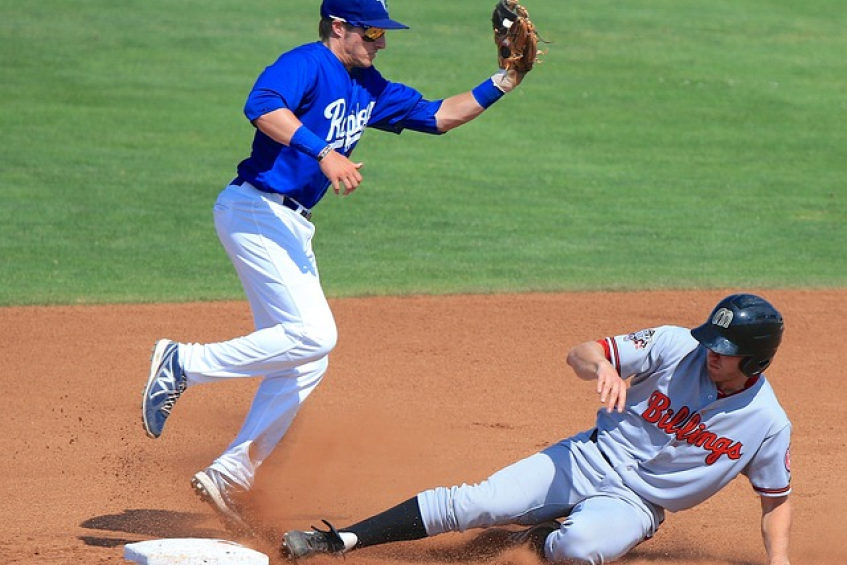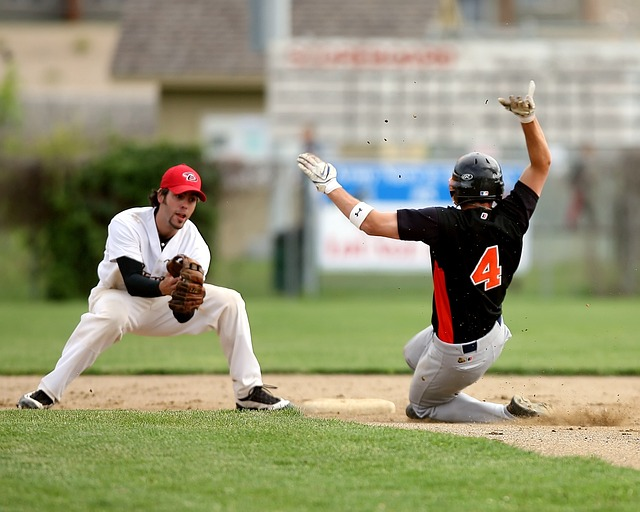
As baseball fans, we've all experienced the thrill of a well-executed double play. This iconic baseball play is a sequence of actions that results in two outs on the same play. There's a particular kind of double play, though, that holds a special place in MLB history: the Ground Into Double Play (GIDP). This article will answer your questions about GIDP, explore the role of double plays in a team's offensive performance, and dig into the MLB records for this intriguing play.
GIDP stands for "Ground Into Double Play." A GIDP occurs when a batter hits a ground ball and the fielding team manages to get multiple outs, usually involving both the batter and a runner, on the same play. These multiple outs often result from a force play where one out is made on a runner coming from first to second base, and another on the batter hustling to first base.
The most common double plays are these ground balls that are well-struck and hit directly to a fielder. However, ground balls that are hit softly can also lead to a double play, depending on the speed of the batter running to first base. This combination of factors makes each GIDP a unique event in a baseball game, a testament to the defensive prowess of the fielding team and sometimes a frustrating moment for the offensive team.
At the heart of the GIDP is the ground ball hit. Once a batter hits a ground ball, the fielding team springs into action. The ball is typically fielded by the second baseman or shortstop, who tags the second base for the first out before throwing the ball to the first baseman for the second out. This is one of the most common double plays, often referred to by the shorthand "4-6-3" or "6-4-3" depending on who fields the ball first.
But a GIDP can occur in a variety of situations. For instance, if a line drive is caught by the first baseman who then tags the base before the runner can return, an unassisted double play results. There can also be a force play at third base if bases are loaded, resulting in a "5-4-3" double play.

In baseball statistics, GIDP is a factor used to evaluate both hitters and pitchers. The MLB leaders in GIDP are usually slower players who hit a lot of ground balls -- often well-struck ground balls that are fielded efficiently by the opposing team. This statistic can negatively impact a team's offensive performance as it can quickly halt momentum and end potential scoring opportunities.
For pitchers, a high GIDP count can indicate effectiveness in keeping the ball low in the strike zone, enticing batters to hit ground balls that can be turned into double plays. It's often said that double plays are a pitcher's best friend, and GIDP is a testament to that adage.
Double plays, including GIDP, can have a significant impact on the outcome of a baseball game. With fewer than two outs, a well-executed double play can end an inning and quash a scoring threat. For the offensive team, a double play can be a momentum killer, especially if it occurs with runners in scoring position.
On the other hand, for the defensive team, a double play can provide a much-needed morale boost, especially in high-stakes situations. Picture this scenario: the bases are loaded with only one out, and the opposing team's power hitter is at the plate. The tension on the field is palpable as the pitcher delivers the ball. The batter makes contact, sending a ground ball towards the shortstop. The shortstop scoops up the ball, tosses it to the second baseman who steps on second base for the first out, and then quickly throws the ball to first base to complete the double play. The crowd erupts as the defensive team successfully navigates a high-risk situation, ending the inning and preventing any runs from scoring. This kind of play can be a significant momentum swing in favor of the defensive team, providing a psychological boost and potentially shifting the overall dynamics of the game.
Double plays also represent a highly strategic aspect of baseball. Both the pitcher and infielders must work in unison to achieve this outcome. The pitcher aims to induce a ground ball by keeping the pitch low in the strike zone. Meanwhile, infielders must be prepared to react quickly and efficiently, often requiring excellent coordination and communication, particularly between the shortstop and second baseman, to turn the double play.
From the offensive perspective, avoiding a double play becomes a key consideration, particularly in situations where there are runners on base with less than two outs. The batter might change their approach, trying to hit the ball in the air or to the opposite field to avoid hitting a ground ball to the infielders. The base runners, too, must be prepared, understanding when to run and when to hold to avoid being caught out.
GIDP has a significant place in Major League Baseball history. This baseball play is not just about a batter hitting a ground ball that results in multiple outs. It's about strategy, skill, and sometimes, a little bit of luck. Over the years, many great players have made their mark in the MLB record books for their ability to avoid GIDP, while others have unfortunately found themselves leading the league in this statistic.
The official scorer of the game records the GIDP statistic, marking it every time a batter hits into a double play. This baseball statistic has been officially recorded since the 1933 season, providing a rich historical dataset for baseball fans and analysts alike.
One notable player in the context of GIDP is Jim Rice, the Boston Red Sox's left fielder. Over his 16-year career in the major leagues, Rice hit into 315 double plays, earning him the dubious honor of being the all-time leader in GIDP as of the end of the 2021 season. On the other hand, some of the greatest hitters in the history of the game, such as Eddie Murray of the Baltimore Orioles and the Cleveland Indians, and Ivan Rodriguez of the Texas Rangers and the Detroit Tigers, have also found themselves with high GIDP numbers.

The strategy of a Ground Into Double Play (GIDP) is an important element within the game of baseball. This defensive play occurs when a batter hits a ground ball that results in two outs being made on the bases. The most common instance of a double play involves a forceout at second base (the runner moving from first to second) and another forceout at first base (the batter attempting to reach first)1.
While it may seem that a GIDP is often the result of a poorly executed hit by the batter, it's also a testament to the strategic approach taken by the pitcher and the infield defense. For pitchers, inducing a GIDP is often a goal, especially when there are runners on base with less than two outs. By keeping the ball low in the strike zone, a pitcher increases the chances of the batter hitting a ground ball. The positioning and quick reactions of infielders also play a crucial role in successfully turning a double play.
The strategy of GIDP also extends to the offensive side. Batters who tend to hit a high number of ground balls, particularly those who are slower runners, are more likely to hit into double plays. Therefore, these players may aim to adjust their batting approach in situations where a double play is a risk, such as trying to hit the ball in the air or aiming for gaps in the infield.
Ultimately, the GIDP is a strategic tool that can dramatically shift the momentum within a game. A successful double play can quickly end an offensive threat and shift the game back into the hands of the defensive team. Conversely, avoiding hitting into a double play can sustain an inning and increase scoring opportunities for the offensive team. This dynamic interplay between offense and defense around the GIDP is a key aspect of baseball strategy.
In summary, the world of baseball is a complex and fascinating one, filled with layers of strategy, skill, and excitement. Whether it's understanding the impact of GIDP on a game's outcome, appreciating the international reach of baseball through the World Baseball Classic, or navigating the search for a local baseball team for your child, we hope this post has deepened your appreciation for the sport.
As fans, we all share in the thrill of a well-executed double play, the anticipation of a tournament between nations, and the joy of finding the right team for young players. The magic of baseball lies not just in the big moments, but also in the detailed nuances and strategies that shape the game.
We hope you continue to enjoy the sport and explore its many dimensions. As we have seen, baseball is a game that continues to evolve, grow, and inspire, both on the local fields and the global stage. From young players just starting their journey to seasoned professionals competing in international tournaments, baseball is a testament to the enduring appeal of teamwork, strategy, and skill. We look forward to sharing more insights, updates, and stories from the world of baseball in future posts. Until then, keep your love for the game alive and swing for the fences!
Chris Sloan is a former baseball league commissioner and travel baseball coach who has made significant contributions to the sport. In 2018, he founded selectbaseballteams.com, a website that helps parents find youth and travel baseball teams in their local areas. Since its launch, the website has experienced impressive growth, offering a wealth of resources including teams, news, tournaments, and organizations. Chris's unwavering passion for baseball and his innovative approach to connecting parents with quality baseball programs have earned him a respected reputation in the baseball community, solidifying his legacy as a leading figure in the world of youth and travel baseball.
There are 0 comments on "What does GIDP Mean in Baseball?"
chandler allen says:
"Hi my name is chandler, i’ve enjoyed..."
On Wanting to tryout for summer ball. as an 18 year old
david graham says:
"With no current MLB team in Canada,..."
On With no current MLB team in
Charles Chavez says:
"To All Coaches: Do you have13U or..."
On Looking for Games